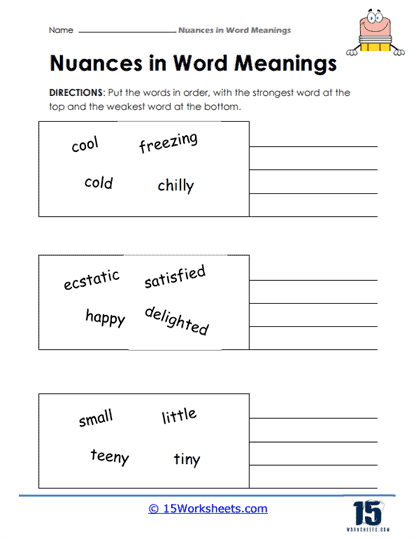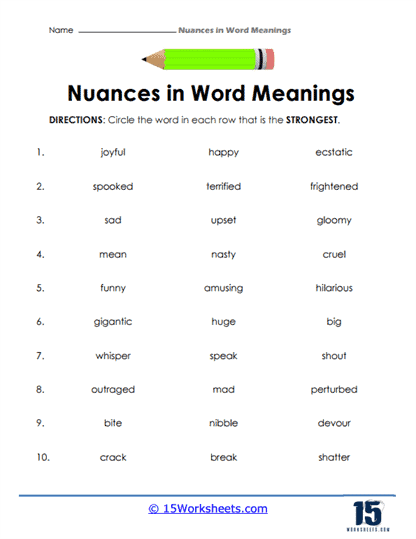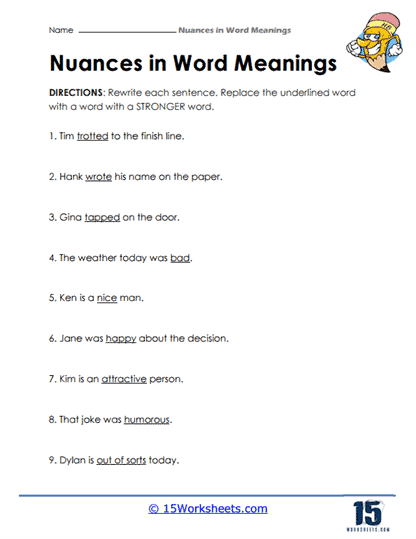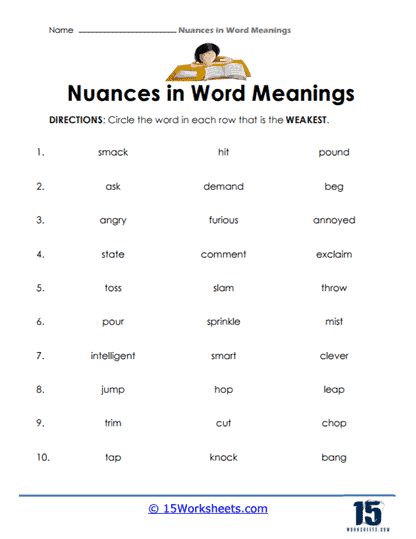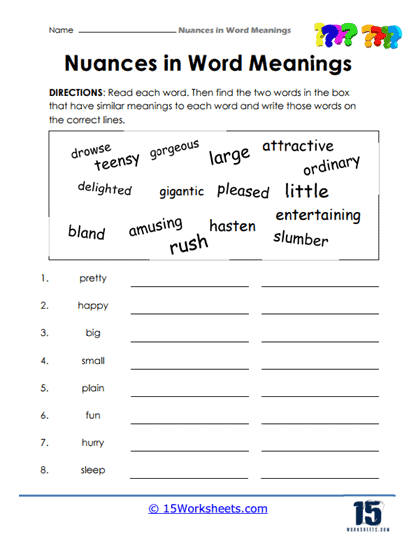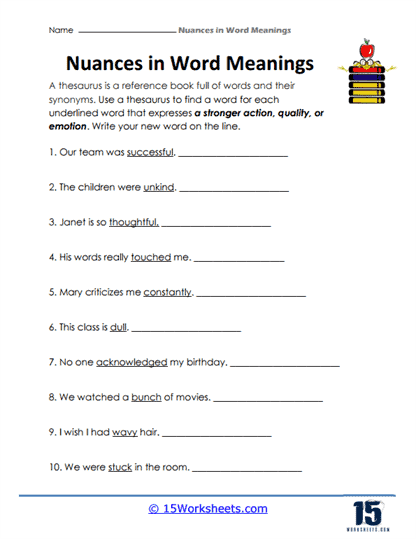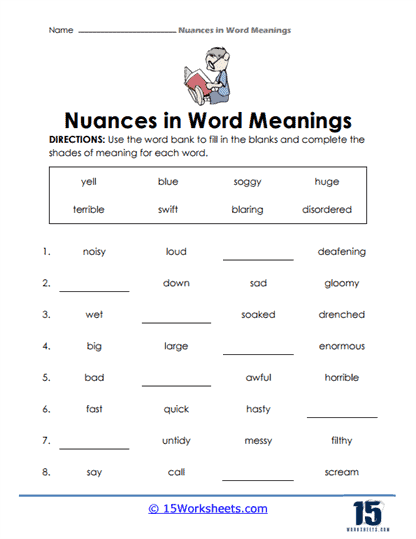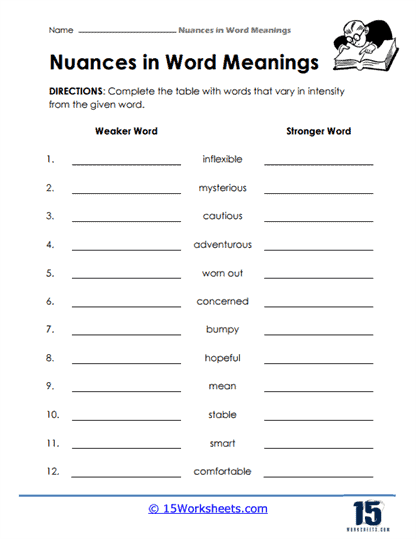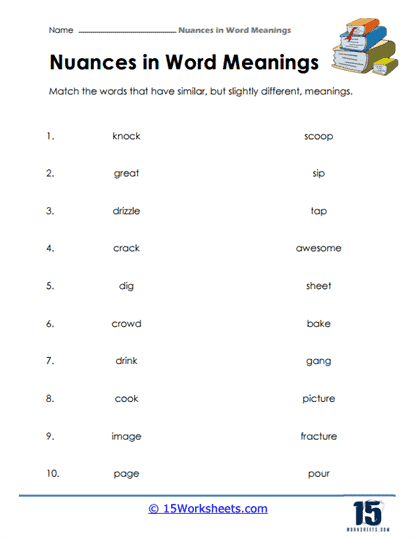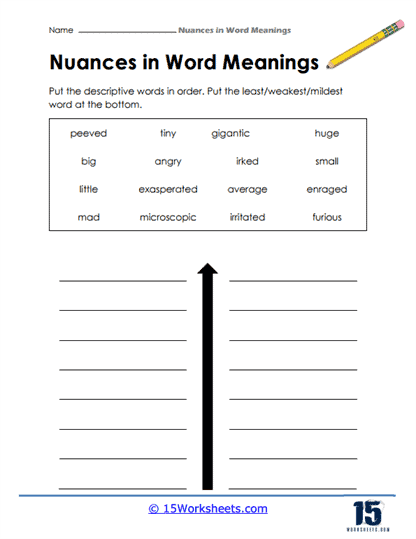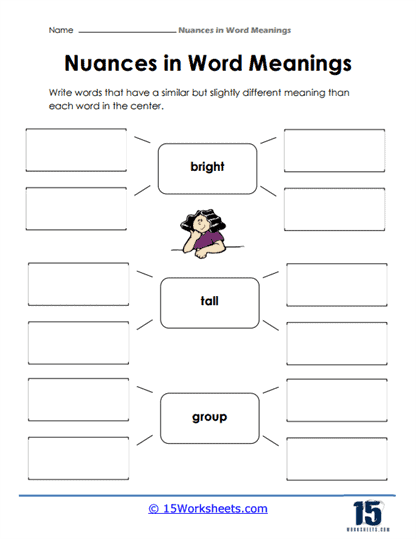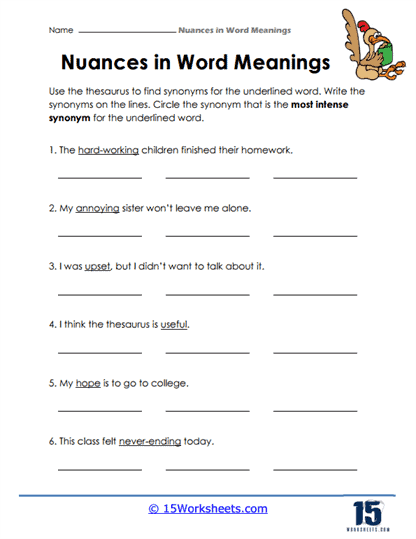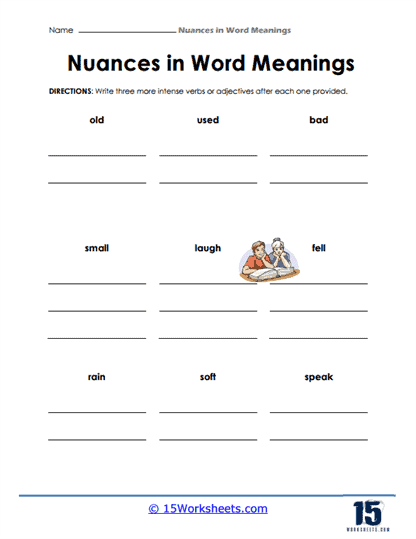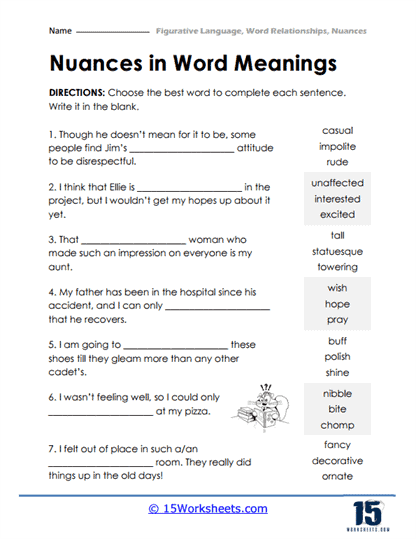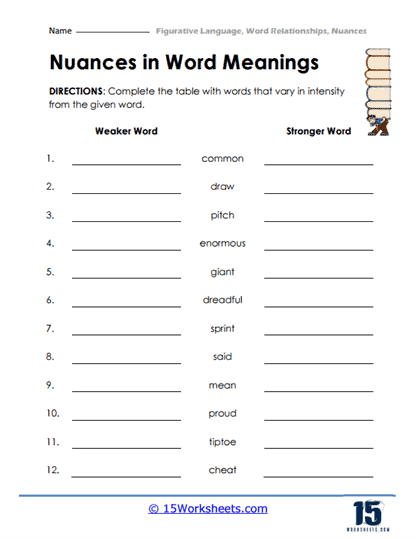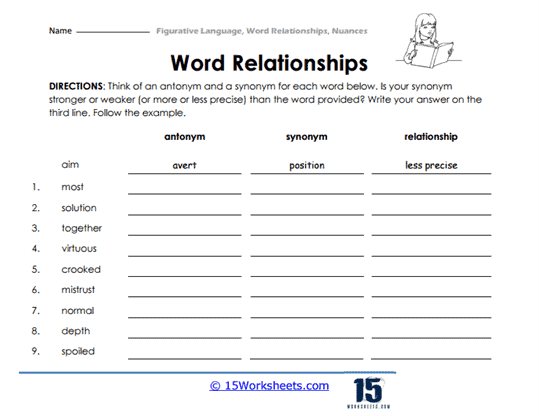Nuances Worksheets
About These 15 Worksheets
These worksheets were created to help students understand and recognize subtle differences in language, particularly in the meanings of words and phrases. These worksheets typically feature a variety of exercises aimed at developing students’ skills in discerning nuances in language usage. One common type of exercise found on Nuances Worksheets involves selecting the most appropriate synonym from a list to fill in a blank in a sentence. In these exercises, students are presented with sentences containing a blank space and a word bank of synonyms. They must choose the synonym that best fits the context of the sentence, considering factors such as tone and connotation.
Another type of exercise found on these worksheets involves categorizing words based on their degrees of intensity or meaning. In these exercises, students are given groups of words related by meaning but differing in intensity, such as “happy,” “joyful,” and “ecstatic.” Students must organize these words according to their intensity levels, from the least to the most intense. This activity helps students understand the subtle variations in word meanings and how different words can convey different levels of emotion or intensity.
Some of the worksheets may include exercises where students are asked to identify the most appropriate word or phrase to replace a given word, considering factors such as formality, register, or context. For example, students might be presented with a sentence containing an informal word and asked to replace it with a more formal synonym. This type of exercise helps students understand how word choice can impact the tone and style of writing.
They also may incorporate activities where students analyze the connotations of words and phrases in different contexts. Students might be asked to consider how the meaning or tone of a sentence changes when different words or phrases are used. By engaging in these exercises, students develop a deeper understanding of the subtleties of language and become more adept at expressing themselves effectively in various contexts.
What Are Nuances In Reading?
An author uses nuances to give character to their writing and evoke the reader’s emotions. When someone reads a book for the first time, they will come across and react to some nuances without realizing it. This is the author’s aim, and it works incredibly well in writing that is intended for a specific audience, like advertisements and campaigns.
The word nuance means subtle changes in meaning. When discussing nuances in literature, nuances refer to subtle indications in an author’s writing through which the author wishes to convey a point without outright declaring it in their writing.
For example, if you want to convey to readers that a setting in a story is unhappy or gloomy without saying it directly. In that case, you could write something like, “The house overlooked a gloomy dark sky, the chirping of the birds had stopped, and the flowers seemed to have lost their vibrance.”
With sentences like these, you can cleverly convey the somber setting of your story without directly saying it. This evokes emotion in the readers’ hearts and connects them with the text.
How to Identify Nuance in Reading?
To identify nuances in reading, we need to pay attention to the context and understand the concept behind connotation. Connotation refers to the feelings or ideas behind a word. When reading a text, focus on the words and the feelings they evoke.
For example, if we take the example mentioned above, “The house overlooked a gloomy dark sky, the chirping of the birds had stopped, and the flowers seemed to have lost their vibrance.”, and focus on the words, you will see how some of the words like a gloomy sky or lost vibrance evoke the feelings of sadness because these words have a negative connotation attached to them.
How Can You Add Nuances To Your Writing?
Nuances are a great way to add an edge to your writing and keep readers engaged. Here are a few ways that you can start adding nuances to your writing:
Pay Attention to Word Choices
Consider creative ways to express a point without explicitly saying it. For instance, if you want to show readers that your character is pressed for time, come up with original language and word choices. You may write; she sprinted her way out of the building rather than writing; she was in a rush as she moved through the building.
Learn From the Professionals and Practice
The skill to add nuances to writing cannot be developed in a day. It comes with practice, writing as much as possible, and experimenting with different writing styles. Moreover, take tips from your teachers and people who have been writing for years or search online for advice from different authors on how to add nuances to writing.
Noticing how others add nuances to writing can help you develop this skill. So, pay attention to small details in other writer’s works to see how they evoke feelings through their words and try to replicate that in your unique way.
How Does Figurative Language, Word Relationships, and Nuances Spice up What We Read
Figurative language, word relationships, and nuances are essential for a well-written piece. Let’s explore each of these factors briefly.
About Figurative Language
Figurative language includes symbolism, sound techniques, and the use of metaphorical language to generate meaning for the reader. The writer doesn’t have to clearly describe the work’s subject for the reader to understand it better. Instead of simply understanding a tale or poem, it allows the reader to infuse the words with their thoughts and feelings. As a result, figurative language will enable readers to identify with the characters in a story, develop the storyline, and find the work’s deeper meaning.
The most prevalent varieties of metaphorical language include simile, personification, symbolism, hyperbole, imagery, oxymoron, paradox, apostrophe, allusions, and irony.
Word Relationships
There are various conceivable word relationships. It’s critical to consider the words in the sentence in connection to one another. The relationship changes when the sequence is reversed. The colon (:) is an abbreviation for the phrase “is to,” which is used when describing word relationships. This is an abbreviation to help you save time and space. Just keep in mind that there are numerous possible types of word relationships.
Nuance
Nuance is a term that refers to minor variances in the meaning of words and phrases. Connotation, concepts, and sentiments connected with a particular word, subtext, or what’s going on beyond the surface of the writing are fundamental factors that contribute to nuance.
How Do These Things Spice up What We Read?
1. Improved Literacy Skills
Introducing figurative language, word relationships, and nuances in writing can capture the audience’s interest by improving their literary skills. You might think it’s a task; teaching metaphorical language doesn’t have to be tedious.
You can employ complicated vocabulary in your literature pieces. The problem, however, is that students often develop a terrible habit of reading too quickly and skimming the surface. If you want them to do more than retell a story’s plot, introduce them to word relationships. Emotion, tone, and mood are conveyed through figurative language. It also reveals subtle distinctions in connotation. As a result of these hints, students are better able to deduce the writer’s intentions.
2. Enhanced Sense of Research
Introducing figurative language, word relationships, and nuances in writing allow your students to delve deeper into a metaphor or simile once they’ve discovered it. Their enhanced research abilities help them find the answers to essential questions in the long run.
Ask them questions: Was there a specific message the writer was trying to convey? What effect does the nuance have on the reader’s point of view? Were they able to better understand the piece? Once they set on to answer these questions, they develop critical thinking that eventually helps them process information at a higher level.
3. Improves the Usability of the Language
English language learners need to learn how to use metaphors and other figures of speech. The symbolic aspect of figurative language often confounds students still learning literal words and phrases.
Many lack the cultural context necessary to grasp the most prevalent types of metaphorical language. Figurative language can be difficult for non-native speakers. Therefore, regular practice can help improve their literacy and communication.
Furthermore, introducing students to frequent English idioms helps them understand the language more deeply. Over 10,000 standard figures of speech in the English language are thought to exist by linguists. Many English language learners rapidly pick up on these expressions because they’re enjoyable to teach.
4. Develops Creativity
Students can readily master figurative language, word relationships, and nuances. Teaching metaphorical language encourages them to express themselves uniquely and creatively. They develop the ability to bend and mold language into work that elicits an emotional response from the reader. If you want to help your child become a better writer, you need to help them learn how to turn words into images with the help of figurative language.

